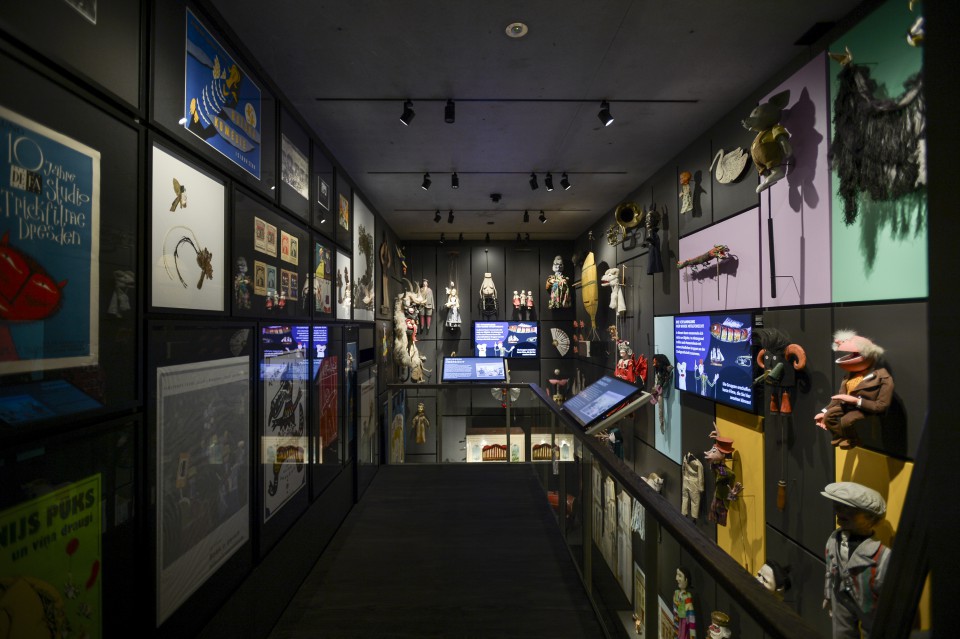The Collection KOLK 17
With over 20,000 objects from the field of puppet theatre, KOLK 17 houses one of the five largest collections in Germany and is certainly one of the most important cultural institutions for puppet theatre in Europe.
We see the collection as a large space for knowledge which is in perpetual motion and must be accessible to the general public. Therefore, one of our most important goals is to make both the collection and the archive area complete with documents as well as a specialised library available to interested parties via a digital infrastructure. This enables the intercultural and interdisciplinary exchange of knowledge about the most diverse forms of puppet theatre.
The history of the collection
Starting in the 1970s, Fritz Fey Jr. (born 1940) began privately collecting the objects. As a cameraman for Norddeutscher Rundfunk, he traveled the world and encountered many forms of puppet theater. In addition to acquiring figures locally, he maintained connections with specialized dealers. Sources for building his collection also included performers at the Hamburger Dom and Hamburg flea markets. Other significant acquisitions came from the estates of the Winter and Schichtl marionette dynasties. Their splendid traveling stages and beautifully crafted marionettes showcase a high point of puppet theater at the beginning of the 20th century. In contrast, the fantastical figures from the 1950s by artist Harry Kramer are more at the intersection of performance, film, and visual art. Another focus of the collection is theater figures from India. Over 1,800 objects—including instruments, hand puppets, various types of marionettes, and a large number of shadow figures—are still awaiting research. Their acquisition was significantly enabled by the contacts of Saraswati Fey, the wife of Fritz Fey Jr., in India. Parts of the oldest holdings trace back to the collecting activities of Fritz Fey Sr. (1912–1986).
After World War II, Fritz Fey Sr. established a marionette theater operation in northern Germany with his wife, Ingeborg Fey. Alongside his active performances, he began early on to collect figures from other puppeteers and display them in the theater’s foyer. Initially, he focused on the hand puppets of traditional fairground "Kasper" players, whose performance tradition in Germany ended in the 1960s. Therefore, KOLK 17 includes hand puppets from such significant players as Walter Büttner, Karl Römer, Diego Schultze, and Kasper Kraus. From the beginning, however, Fey Sr. was also interested in forms of puppet theater from other countries.
In 2011, the Possehl Foundation acquired the collection from Fritz Fey Jr. The collection of the Lübeck Marionette Theater, with the puppets performed by Ingeborg Fey until 2005, also became part of the KOLK 17 collection in 2021. In recent years, it has been expanded primarily with modern puppet theater productions.
Research projects
We have begun to explore a selection of African objects from Mali and a collection of Chinese iron rod puppets in two research projects with experts from these countries. The findings have been incorporated into the current exhibition. Another research project in the coming years will focus on the figures from Vietnamese water puppetry.
KOLK 17 Collection Online
KOLK 17 wants to make its collection accessible to the public and thus strengthen participation for all. The online collection not only serves as a factual and professional research resource for experts, but also as an exploratory introduction for everyone through curated content.

Do you own puppets, props, playbills, scripts, or other items relevant to the history of puppet theater? Consider contributing your treasures to the KOLK 17 collection.
Online Collection
Since the beginning of 2020, staff from the Collection & Science department have been working intensively on a system that will make the collection, which consists of an amalgamation of approximately 20,000 artefacts, accessible through a pragmatic administration with ‘controlled’ terminologies. The aim is to create a digital research infrastructure that will also be available as an online collection for external international users.
How do we want to deal with unclear object Biographies?
The archives of museums are not only places where objects are stored. They are spaces of knowledge and repositories of cultural heritage. We would like to open up the KOLK 17 collection to a diverse range of experts in order to re-examine the ‘stored knowledge’ surrounding the objects in the collection. Especially in the case of objects of ‘non-European provenance’, we would like to critically reflect on previous scholarly knowledge by examining the processes of separation from their cultural context and their subsequent classification . Researching the object biographies is central for us. This includes actively contacting the respective artists or players or their descendants as well as networking with scholars from the respective communities of origin. We work transparently and (self-)critically; disclosing unresolved object provenances and knowledge gaps.